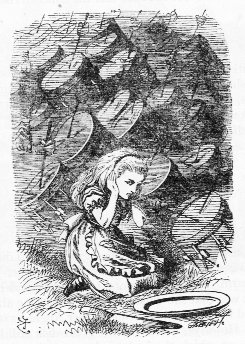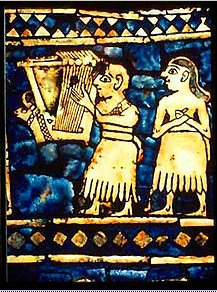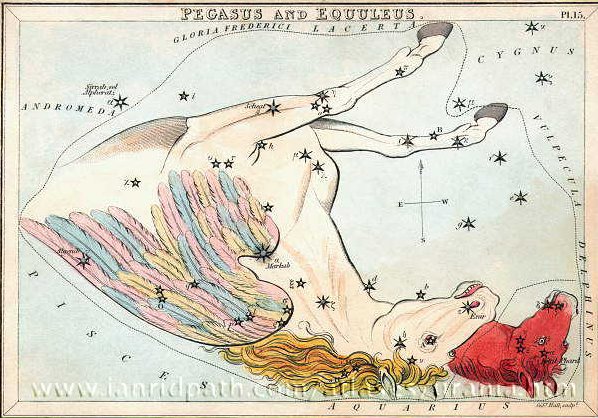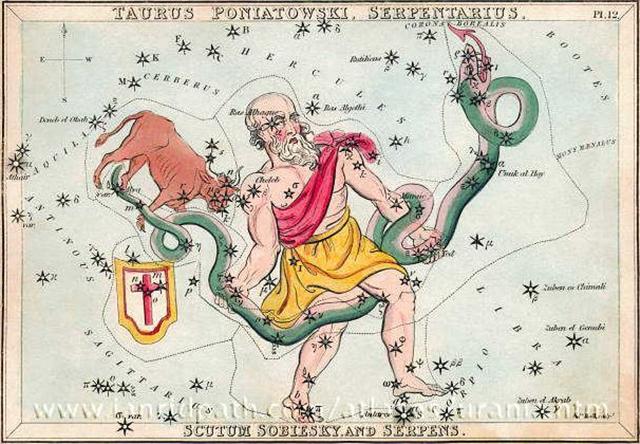2. The basic cosmic structure has the sky dome (Ç) above and the flat earth below. The model can then be expanded by pointing out how caves lead down to the damp and misty Underworld, a gloomy place where everything is upside down (È) and where Sun is moving from the horizon in the west to the horizon in the east, going down in a hole there in order to rise again in the morning of the world of light, of the living. Up contra down is more basic than right contra left, yet both dimensions are fundamental:  In this ancient picture (from Cecilia Lindqvist's Tecknens Rike) the Chinese artist has drawn 2 horses drawing a vehicle on 2 wheels. On the roof of the carriage 2 drummers are madly beating the centrally located drum. Each has 2 drum-sticks and 2 * 2 = 4. In front of Alice, on the ground, there is a piece of cloth and a plate, above and surrounding her a multitude of beating drums:
Above the drummers there is a kind of dragon with 2 heads, one towards right (the front) and one towards left, perhaps corresponding to the Azure Dragon. The Yellow Dragon would then be the one in front: "The legendary Yellow Emperor was sometimes said to have transformed into a dragon that resembled his emblem and ascended to Heaven. Since the Chinese consider him to be their ancestor, they sometimes refer to themselves as 'the children of the dragon'. This legend also contributed towards the use of the Chinese dragon as a symbol of imperial power." (Wikipedia) The front dragon's head is higher up, which leaves an opening in front. The front drummer has no visible legs and he seems to be sitting down. But the left drummer is standing up, yet he has a lower position, probably of necessity because of the sloping roof at the back side. Inside the wagon are 2 pairs of musicians, playing sheng, a kind of mouth organ. A 5th person is looking ahead in order to drive the vehicle forward. "Chinese free-reed wind instruments named he and yu were first mentioned in bone oracle writings dating from the 14th-12th centuries BC, and were identified in later texts as types of sheng. The first appearance of the word 'sheng' is in some of the poems of Shijing (Book of Odes), dating back c. 7th century BC. Ancient instruments with gourd wind chambers, varying numbers of pipes, with bamboo or metal reeds have been discovered in archaeological finds at the tomb of the Marquis Yi of Zeng (c. 433 BC) in present-day Hubei province, and the Han tombs at Mawangdui (c. 2nd century BC) in Hunan province. In the eighth century, three yu and three sheng were sent to the Japanese court and these have been preserved in the Shōsōin imperial repository in Nara. All the instruments had 17 pipes with a long curving mouthpiece and are very similar to the traditional sheng in use today. However variants with different numbers of pipes, and chromatic instruments have been documented over the centuries." (Wikipedia) The pair of musicians at left has shengs with 8 respectively 5 pipes, the pair at right both have such with 6 pipes. 8 + 5 + 6 + 6 = 25, the number of Saturn (the Yellow Emperor): ... Saturn does give the measures: this is the essential point. How are we to reconcile it with Saturn the First King, the ruler of the Golden Age who is now asleep at the outer confines of the world? The conflict is only apparent, as will be seen. For now it is essential to recognize that, whether one has to do with the Mesopotamian Saturn, Enki / Ea, or with Ptah of Egypt, he is the 'Lord of Measures' - spell it 'me' in Sumerian, 'parshu' in Akkadian, 'maat' in Egyptian. And the same goes for His Majesty, the Yellow Emperor of China - yellow, because the element earth belongs to Saturn - 'Huang-ti established everywhere the order for the sun, the moon and the stars'. The melody remains the same ... (Cfr at Fishing Up Land.)
I can perceive a cosmic order,
where the great drum corresponds
to the ruler of the sky region
('Hanan') and where the
people inside the carriage ('Hurin')
are divided into a front and a
left compartment by the 'trunk'
of the 'drum tree' above.
The inside muscians are ordered pairwise, facing each other and maybe alluding to how Moon has 2 faces, waxing respectively waning. 2 * 7 = 14 and 2 * 14 = 28, equal to the number of Chinese lunar mansions (with the Yellow Dragon as number 29):
At the top of this 'trunk', above the great drum, there is a sign which connects the tails of the pair of sky roof dragons (oriented like the sign of Janus, not facing each other). It could allude to the nabla (Ñ, ανάδελτα). With musicians both inside and on top of the carriage the 'heart of music' (del, the Egyptian harp) would say who really ranks highest:
I suspect my ideas regarding henua ora (see The Whip) are relevant here. The 'living earth' (ψ) presumably corresponds to the center of attention. To its left is the past and in front is the future. Only the present is 'whipping us to action'.
There is no sign of any dead or
wounded serpent, but the central
position, with the great drum
(with a hexagonal silhouette), ought to represent the Sun king. Maybe the front
compartment, with 2 * 6 = 12
organ pipes, corresponds to the first
part of the cycle, with Sun
present, in contrast to the back
compartment with 8 + 5 = 13
pipes, corresponding to the rest
of the year.
The 'bowl' of the carriage has ca 90 squares and is formed not rounded but similar to the bottom half of the hexagonal drum shape above (though turned 30º).
What moves time ahead? Maybe a
pair of horses. According to
Urania's Mirror there is a
pair of horses in the area of
Pegasus, though they are upside down:
The great mystery of why time moves ahead can be explained by comparing it to a carriage packed full with time measures in harmony and drawn by horses. Or it can be explained by someone on foot carrying time (escpecially if the carriage wheel was not a integral part of the culture, like in South America). "A 'Year Bearer' is a Tzolk'in day name that occurs on the first day of the Haab'. If the first day of the Haab' is 0 Pop, then each 0 Pop will coincide with a Tzolk'in date, for example, 1 Ik' 0 Pop. Since there are twenty Tzolk'in day names and the Haab' year has 365 days (20 * 18 + 5), the Tzolk'in name for each succeeding Haab' zero day will be incremented by 5 in the cycle of day names ..." (Wikipedia) Although Ophiuchus belongs in the 18th hour the Serpent has its tail in the 19th hour and we will therefore postpone the further discussion:
But I cannot resist pointing out the prominent bull (Taurus Poniatowski) which presumably corresponds to the bull of the ancient Sumerian lyre above. |




